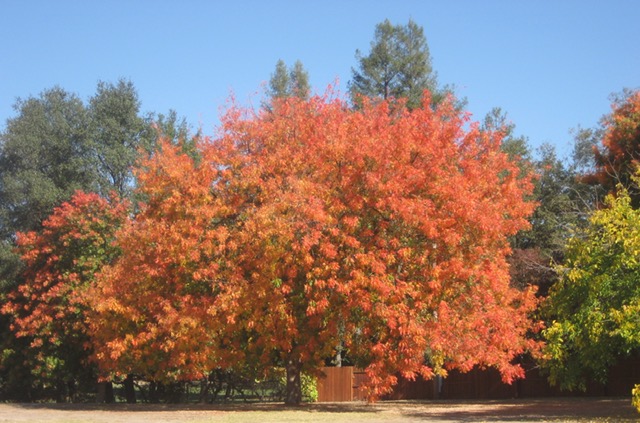
Want to help? Sacramento Tree Foundation has many activities

|
|
Trees in many colors -- one of the great things about the outdoors in fall. Help
plant trees or learn more about them through the Sacramento Tree
Foundation. (Photo: Kathy Morrison)
|
Trees are the stars of fall. Their changing colors demand notice, giving the landscape new looks every day as the green leaves turn to red or gold or orange, and then drop to the ground. A fluffy tree one day -- looking at you, gingko -- can be a sketch of itself the next.
Fall is the best time to plant trees, too. The soil still is warm, which allows roots to grow, but the air temperatures are moderate, so the young tree isn't under heat stress.
The Sacramento Tree Foundation is in the midst of its fall neighborhood tree planting and care events, and welcomes volunteers of any age, with or without tree-planting experience.
-- Sierra Woods, Folsom, 8:45 a.m. to noon, Saturday, Nov. 6. Trees will be planted at several residents' homes.
-- Fisherman's Lake, Natomas, 1-4 p.m. Sunday, Nov. 7. This is a mulch-spreading event for the native trees that were planted at the site a few years ago.
-- Jordan Family Park, Elk Grove, 9 a.m. to noon, Saturday, Nov. 13. This is a reforestation activity for the park, with native trees to be planted along a bike path. Mulching also will be done.
-- Old North Sacramento, 8:45 a.m. to 1 p.m., Saturday, Dec. 11. This event will add street trees to the neighborhood.
If you'd prefer to look and learn about some of Sacramento's trees, and have a bike available, this Sunday the SacTree folks are leading a tour of the Hollywood Park neighborhood's trees starting at 1 p.m. It will conclude at 5 p.m. at Two Rivers Cider.
And SacTree on Nov. 20 plans an acorn harvesting day from 9 a.m. to noon. Location is still TBA.
Register for all SacTree activities at https://www.sactree.com/events .
Meanwhile, here are some things to remember when planting trees:
-- Don't plant a tree too deep. The "root flare" should be at or slightly above the soil line to keep the tree from suffocating. The planting hole should be no deeper than the actual rootball, but it should be wide.
-- Remove the nursery stake. It's there only to protect the tree during transit -- it's not meant to be left on while the tree grows, and actually can limit its growth.
-- If stakes are necessary to keep the tree upright, there should be a pair of them, each about 18 inches away from the trunk, attached with loops that let the tree sway. That's how it gets stronger! Then remove the stakes after a year or two, depending on its growth.
These and other tips for tree-planting can be found at sactree.com/howtoplant and, for fruit trees specifically, in this UC Agriculture and Natural Resources publication, https://anrcatalog.ucanr.edu/pdf/8048.pdf .
Comments
0 comments have been posted.Sacramento Digs Gardening to your inbox.
Food in My Back Yard Series
April 22: Should you stock up on fertilizer? (Yes!)
April 15: Grow culinary herbs in containers
April 8: When to plant summer vegetables
April 1: Don't be fooled by these garden myths
March 25: Fertilizer tips: How to 'feed' your vegetables for healthy growth
March 18: Time to give vegetable seedlings some more space
March 11: Ways to win the fight against weeds
March 4: Potatoes from the garden
Feb. 25: Plant a fruit tree now -- for later
Feb. 18: How to squeeze more food into less space
Feb. 11: When to plant? Consider staggering your transplants
Feb. 4: Starting in seed starting
Sites We Like
Garden Checklist for week of April 27
Once the clouds clear, get to work. Spring growth is in high gear.
* Set out tomato, pepper and eggplant transplants.
* From seed, plant beans, beets, cantaloupes, carrots, corn, cucumbers, melons, pumpkins, radishes and squash. Plant onion sets.
* In the flower garden, plant seeds for asters, cosmos, celosia, marigolds, salvia, sunflowers and zinnias. Transplant petunias, zinnias, geraniums and other summer bloomers.
* Plant perennials and dahlia tubers for summer bloom. Late April is about the last chance to plant summer bulbs, such as gladiolus and tuberous begonias.
* Transplant lettuce and cabbage seedlings.
* Weed, weed, weed! Don’t let unwanted plants go to seed.
* April is the last chance to plant citrus trees such as dwarf orange, lemon and kumquat. These trees also look good in landscaping and provide fresh fruit in winter.
* Feed citrus trees with a low dose of balanced fertilizer (such as 10-10-10) during bloom to help set fruit. Keep an eye out for ants.
* Apply slow-release fertilizer to the lawn.
* Thoroughly clean debris from the bottom of outdoor ponds or fountains.
* Start thinning fruit that's formed on apple and stone fruit trees -- you'll get larger fruit at harvest (and avoid limb breakage) if some is thinned now. The UC recommendation is to thin fruit when it is about 3/4 of an inch in diameter. Peaches and nectarines should be thinned to about 6 inches apart; smaller fruit such as plums and pluots can be about 4 inches apart. Apricots can be left at 3 inches apart. Apples and pears should be thinned to one fruit per cluster of flowers, 6 to 8 inches apart.
* Azaleas and camellias looking a little yellow? If leaves are turning yellow between the veins, give them a boost with chelated iron.
* Trim dead flowers but not leaves from spring-flowering bulbs such as daffodils and tulips. Those leaves gather energy to create next year's flowers. Also, give the bulbs a fertilizer boost after bloom.
* Pinch chrysanthemums back to 12 inches for fall flowers. Cut old stems to the ground.
* Mulch around plants to conserve moisture and control weeds.